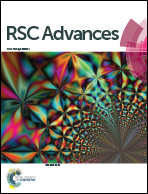Research of the optimum molar ratio between guest and host chromophores in binary chromophore systems for excellent electro-optic activity
Abstract
A series of binary chromophore systems (BCSs) based on electro-optic (EO) polymers P1–P5 and guest chromophores C1 and C2 were designed and prepared. The poled films of these BCSs showed large EO coefficients (r33 = 57–160 pm V−1), which were much higher than the sum of their individual components. The optimum molar ratio (OMR) between guest and host chromophores was first systematically explored by changing their molar ratios (Ng : Nh) in the following BCSs: (1) C1/P2; (2) C1/P4; (3) C2/P1; (4) C1/P5. Meanwhile, the influence of the types of the chromophores and the polymer main chains on the OMR was also studied. Finally, these results indicated that the BCSs showed the greatest r33 growth rates when the Ng : Nh was 1 : 1. Hence, the OMR in BCS was 1 : 1 and the types of the chromophores and the polymer main chains were found to have little influence on the OMR. At the OMR, the r33 values were even 2.1 times of the sum of their individual components. We give a model for this phenomenon. The research of OMR in BCSs provided a promising way to further improve the EO coefficients.


 Please wait while we load your content...
Please wait while we load your content...